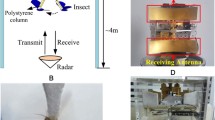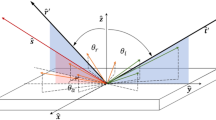Abstract
The length and width of insect body are critical parameters for entomological radar species identification. However, the body width is not measurable in entomological radar currently. In this study, the scattering matrices (SM) of 159 insect specimens were measured using an X-band fully polarimetric laboratory rig in a microwave anechoic chamber. The relationships between the polarimetric radar cross-section (RCS) parameters extracted from the SM and the insect body width were studied. It was found that all these parameters have good correlations with the body width and can be used to estimate it. The mopping relationships between the polarimetric RCS parameters and the body width are built, and can be used as empirical formulas for insect body width estimation. In addition, based on these parameters, two new body length estimation methods were proposed. The performance of the proposed body width and length estimation methods when the echo signals were noisy was analyzed. It was found that the parameter that represents the product of the RCSs when the polarization direction is parallel and perpendicular to the insect body axis has the best performance for both the estimation of body width and length.
Similar content being viewed by others
References
Hu G, Lim K S, Horvitz N, et al. Mass seasonal bioflows of high-flying insect migrants. Science, 2016, 354: 1584–1587
Smith A D, Reynolds D R, Riley J R. The use of vertical-looking radar to continuously monitor the insect fauna flying at altitude over southern England. Bull Entomol Res, 2000, 90: 265–277
Hu C, Wang Y X, Wang R, et al. An improved radar detection and tracking method for small UAV under clutter environment. Sci China Inf Sci, 2019, 62: 029306
Cui K, Hu C, Wang R, et al. Deep-learning-based extraction of the animal migration patterns from weather radar images. Sci China Inf Sci, 2020, 63: 140304
Zhou C, Wang R, Hu C. Equivalent point estimation for small target groups tracking based on maximum group likelihood estimation. Sci China Inf Sci, 2020, 63: 189302
Drake V A, Reynolds D R. Radar Entomology: Observing Insect Flight and Migration. London: CABI, 2012
Chapman J W, Drake V A, Reynolds D R. Recent insights from radar studies of insect flight. Annu Rev Entomol, 2011, 56: 337–356
Long T, Hu C, Wang R, et al. Entomological radar overview: system and signal processing. IEEE Aerosp Electron Syst Mag, 2020, 35: 20–32
Drake A. Automatically operating radars for monitoring insect pest migrations. Insect Sci, 2002, 9: 27–39
Drake V A, Hatty S, Symons C, et al. Insect monitoring radar: maximizing performance and utility. Remote Sens, 2020, 12: 596
Hu C, Li W Q, Wang R, et al. Insect flight speed estimation analysis based on a full-polarization radar. Sci China Inf Sci, 2018, 61: 109306
Smith A D, Riley J R, Gregory R D. A method for routine monitoring of the aerial migration of insects by using a vertical-looking radar. Phil Trans R Soc Lond B, 1993, 340: 393–404
Hu C, Kong S Y, Wang R, et al. Identification of migratory insects from their physical features using a decision-tree support vector machine and its application to radar entomology. Sci Rep, 2018, 8: 5449
Drake V A. Distinguishing target classes in observations from vertically pointing entomological radars. Int J Remote Sens, 2016, 37: 3811–3835
Hao Z H, Drake V A, Taylor J R, et al. Insect target classes discerned from entomological radar data. Remote Sens, 2020, 12: 673
Drake V A, Chapman J W, Lim K S, et al. Ventral-aspect radar cross sections and polarization patterns of insects at X band and their relation to size and form. Int J Remote Sens, 2017, 38: 5022–5044
Aldhous A C. An investigation of the polarization dependence of insect radar cross sections at constant aspect. Dissertation for Ph.D. Degree. Cranfield: Cranfield Institute of Technology, 1989
Chapman J W, Smith A D, Woiwod I P, et al. Development of vertical-looking radar technology for monitoring insect migration. Comput Electron Agr, 2002, 35: 95–110
Hobbs S E, Aldhous A C. Insect ventral radar cross-section polarisation dependence measurements for radar entomology. IEEE Proc Radar Sonar Navig, 2006, 153: 502–508
Hu C, Li W D, Wang R, et al. Insect biological parameter estimation based on the invariant target parameters of the scattering matrix. IEEE Trans Geosci Remote Sens, 2019, 57: 6212–6225
Zrnic D S, Ryzhkov A V. Observations of insects and birds with a polarimetric radar. IEEE Trans Geosci Remote Sens, 1998, 36: 661–668
Melnikov V M, Istok M J, Westbrook J K. Asymmetric radar echo patterns from insects. J Atmos Ocean Tech, 2015, 32: 659–674
Hu C, Li W D, Wang R, et al. Accurate insect orientation extraction based on polarization scattering matrix estimation. IEEE Geosci Remote Sens Lett, 2017, 14: 1755–1759
Li W D, Hu C, Wang R, et al. Experimental validations of insect orientation extraction based on fully polarimetric measurement. J Eng, 2019, 21: 7954–7957
Hu C, Li W D, Wang R, et al. Discrimination of parallel and perpendicular insects based on relative phase of scattering matrix eigenvalues. IEEE Trans Geosci Remote, 2020. doi: https://doi.org/10.1109/TGRS.2019.2959622
Mirkovic D, Stepanian P M, Kelly J F, et al. Electromagnetic model reliably predicts radar scattering characteristics of airborne organisms. Sci Rep, 2016, 6: 35637
Acknowledgements
This work was supported by Special Fund for Research on National Major Research Instruments (Grant No. 31727901).
Author information
Authors and Affiliations
Corresponding author
Rights and permissions
About this article
Cite this article
Li, W., Hu, C., Wang, R. et al. Comprehensive analysis of polarimetric radar cross-section parameters for insect body width and length estimation. Sci. China Inf. Sci. 64, 122302 (2021). https://doi.org/10.1007/s11432-020-3010-6
Received:
Revised:
Accepted:
Published:
DOI: https://doi.org/10.1007/s11432-020-3010-6




